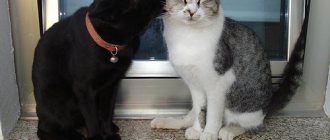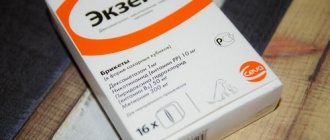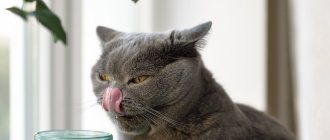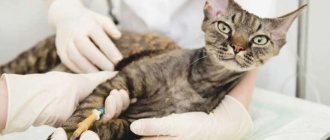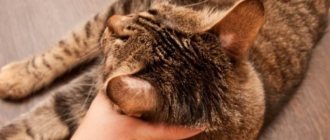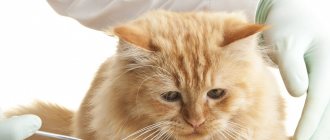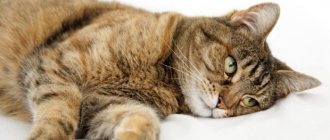A cat is an affectionate and gentle animal that has retained in its genes a love of freedom and a sense of protection in times of danger. Cats are constantly sharpening their claws. With such actions they mark their territory and renew the claw plate; in case of danger, they release sharp claws, thereby defending themselves. They can extend their claws during play. Pet owners often suffer from this, because who would like scratches on their hands and damaged furniture. This problem can be solved by shortening the animal's claws. It is difficult to do this with ordinary scissors, because the cat’s claw plate has a complex structure and is thicker than human nails. To trim claws, you will need a cat nail clipper. Using a nail clipper, you can quickly and accurately trim your pet's claws.
Types of nail clippers
Before choosing, check out the possible types of nail clippers for cats. Which one is better is up to you to decide. But among the popular mechanical ones there are guillotine nail clippers, scissors, and pruners. You may come across an electric grinder. But it requires certain skills and is difficult to use at home.
Claw-guillotine
Despite the intimidating name, guillotine-type nail clippers are very popular among owners. The operating principle of a medieval execution weapon is reproduced with frightening accuracy. The nail clipper-guillotine provides:
- space for claw;
- trigger mechanism;
- a blade cutting off a doomed claw.
Despite the ease of use, the guillotine claw clipper will require some skills from the owner: the moment the trigger is pressed, the doomed claw falls out of sight. This can cause injury to the cat. This nail clipper is suitable for adult cats and cats with hard claws.
Nail clipper-secateurs
A less exotic and bloodthirsty claw cutter is also called a “secateurs” or “nippers.”
These look like ordinary pliers or garden shears, which in addition to comfortable handles have:
- Fuse. A lever that blocks the opening of the cutting part when not in use.
- A limiter that allows you to measure the part of the claw to be cut.
It is easy and safe to use. You need to place the claw between the two ends of the claw clipper, removed from the safety lock, and bring the handles together. Suitable for both kittens and adult cats.
Nail clipper-scissors
If you are used to using ordinary scissors, but understand that for cat claws you need far from manicure devices, there is a way out. In addition to the guillotine and pruning shears with a limiter, they also produce very simple tools for cats. They do not have a bloodthirsty mechanism or frills in the form of limiters and fuses.
Nail clippers-scissors for cat claws are practically no different from a regular manicure device: the same handles and operating principle.
Only the blades of the scissors differ: the inner sharp surfaces have a special curve, making it convenient to place a claw between them.
Training kittens
Cats are very willful pets; in their opinion, forcing them to do something unpleasant is unrealistic. And pets often don’t like cutting their claws very much . The sooner you start training, the easier and faster you can achieve results.
To begin with, it is important to show that the owner will never offend. If the kitten does not respond to the call, you can lure it with something tasty or intriguing, for example, a favorite toy. Having established contact, you need to assess his emotional state at the moment. If your pet is relaxed and in a good mood, you can begin training. If the cat is excited or out of sorts, it is better to postpone the procedure until a more appropriate time and just play or caress the pet. It is important that the owner’s actions are non-violent, but at the same time confident.
Once the kitten is relaxed, you can show him the tools. Having placed the pet on your lap, carefully and securely holding the pet, you need to let the nail clipper smell, perhaps the kitten will rub against it (this means that the cat has marked the object, since there are glands on the face that secrete a secretion with an odor that is elusive to humans, but noticeable to cats , and next time the pet will understand that the object is familiar to him and does not pose a threat).
Is it possible and how to rinse a cat’s nose with saline solution?
How to choose?
To use a nail clipper without problems and disappointments, choose a tool taking into account the individual characteristics of your cat:
- The guillotine is considered the best option because it is equipped with a sharp and reliable blade. If the claws are not dense, similar to human nails, then nail clippers-scissors or pruning shears will do.
- For inexperienced nail fighters or those lacking self-confidence, pruning shears are the best choice: they will help avoid injury. It is better for such owners to refuse the guillotine.
- A cat nail clipper in the form of scissors is suitable for conservatives who are suspicious of unusual accessories.
It is not at all necessary that the most expensive nail clipper will be the best. You can buy a good option by spending an amount of money that is acceptable to you.
Pay attention to:
- convenience. The handles should fit well in the palm and not slip;
- blade quality. Material – stainless steel. Well sharpened and reliable.
Don't expect a good nail clipper to be cheap.
It is strictly forbidden to trim dogs' nails with any household tools. This is directly related to the special density and structure of the claw. You cannot use nail clippers that are intended for cats. Using the wrong tool can lead to injury, claw splitting, and bleeding.
Recommendations for choosing a nail clipper.
- Guillotine nail clippers are suitable for cutting soft nails, usually found on small to medium breeds or puppies.
- Secateurs are capable of cutting claws of any thickness. Great option for large dogs.
- Scissors are uncomfortable to hold in your hand, which can inadvertently injure the dog or damage the nail itself. Best suited for emergency trimming of long but thin nails.
- It is important to choose the optimal size. The nail clipper for large dogs should be 16–18 cm, for medium dogs – 14–16 cm, for small dogs – 8–11 cm.
- An electric claw trimmer is suitable for filing claws of any thickness. It is better to accustom an animal from childhood, so as not to frighten it later with noise and smell. The tool allows you to round the cut line as much as possible, the dog will not scratch the owners or furniture.
- A high-quality product leaves a smooth and even cut. The slightest imperfections indicate that the material of the nail clipper is of poor quality or the blades are not sharpened properly.
- The best option is considered to be a tool with rubberized handles. This way you can control the situation as much as possible during the procedure.
Read more: Rating of the TOP 7 best GSM alarms for the home: which one to choose, reviews, price
What are they?
Claws are natural formations of skin-derived tissue at the tips of the outer phalanges of the fingers of many animals.
They are covered on the outside with a dense layer, inside they contain a network of blood vessels and nerve endings, which must be taken into account when cutting so as not to injure your pet. Cat claws are thin, sharp, retractable. This organ plays a big role in the life of pets: with the help of their claws, cats hunt, defend themselves, climb, maintain balance, play and do many other things. At rest, a cat's claws are always retracted, but if necessary, pets quickly release them. If your cat's claws are always extended or half retracted, you need to pay attention to the pet's health. It's a good idea to take him to the vet and the doctor can determine if there are any underlying conditions or if his nails just need trimming.
Under natural conditions, cat claws do not wear off, as they are protected by a fold of skin and are constantly renewed. They are dense and keratinized, but have a certain layered structure, which allows the outer cover to be regularly renewed. But in some pets they tend to grow back quickly, so it is important to always monitor their condition to prevent problems.
Reviews
About two years ago I ordered nail clippers. My friends also ordered the same big one for a Labrador. My dog is no longer afraid of the manicures I give her. The nail cutter cuts like clockwork and does not break the claw. The cut is always straight. The rubber handles are very comfortable, there is a lock and a limiter.
Masha
I now have two dogs - an adult Yorkie and a Chihuahua puppy. She chose the claw cutter herself and held it in her hand. A small dog doesn't need a big nail clipper. For Yorkies I use a guillotine. Then I process it with a file, then the claws turn out more even.
If you accidentally cut a claw until it bleeds, immediately sprinkle it with dry potassium permanganate.
Tasya
We use a nail clipper - a guillotine, as in the picture, from Trixie. Serves for more than ten years. The dogs are medium-sized - a German Shepherd and a medium-sized mongrel.
Alina
The cat is active: if you don’t trim your claws in time, you’ll get scratches. Trained to use a claw machine. Does not touch furniture or wallpaper. I suffered for a long time and cut it with scissors and forceps. I used several manicure sets for her. Then I saw a review about nail clippers on one of the forums. I ordered it online but couldn’t find it in our city. I've been using it for three years now. There is no limit to happiness. Karina, 33 years old
The cat materialized on our balcony out of thin air. They went around all the neighbors - no one recognizes him as one of their own. They left because of the children. Red has no manners at all. It doesn’t bother us, but the wallpaper in the hallway has been torn apart in a week. The reaction to the scratching post is still weak. I bought a nail clipper-secateurs with a limiter. Nice, comfortable in the hand. I practice claws, though, only I do - it doesn’t work for others. Victor, 42 years old
I got used to doing cat manicures with regular scissors. A friend saw it once and had to drink it with valerian. I bought and gave Murza a guillotine claw clipper. She said that she is not against cruelty to animals. It was difficult to use at first. The guillotine is unusual after scissors. There were some injuries. But now I understand that the option is better than ordinary scissors. Ira, 18 years old
Tools and their prices
In addition to maintaining the health of your four-legged friend, caring for your cat’s claws is also necessary to ensure that the cat does not damage furniture and other items in the house, as often happens. If a cat, living in a house or apartment, has access to the street, its claws should not be trimmed. Coming out of hiding unarmed is very dangerous. However, if the pet is a complete sofa dweller, the owner decides whether to shorten the claws or not. The main thing is to prevent excessive nail growth.
Necessary tools that the owner must have:
We trim the claws with special pliers
Hair clippers
You can also often hear the name “nippers”. This is a convenient and inexpensive tool, it comes in different sizes, but small ones are suitable for cats. It looks like a cross between small short scissors and curved wire cutters.
The working surface is semicircular and sharp, which allows you to grasp the claw, fix it and trim it. Prices vary - it all depends on the manufacturer, the materials from which the tool is made and the size of the nail clipper: from 50 to 550 rubles.
We use a nail cutter - a guillotine to trim claws
Nail clipper guillotine for trimming
It is also often used by professional groomers (people who tidy up the appearance of animals: bathe, cut, comb, treat eyes, ears, claws, etc.) and ordinary owners.
The design of a claw cutter - guillotine - is a solid ring where the tip of the claw is placed, and a small flat sharpened plate, which, in fact, chops off the excess. Operated by a spring handle. You can buy it at any pet store for about 100 – 600 rubles.
Specialized nail file
Files
Everyone knows the tools that people actively use. They have a rough flat surface made of metal, glass, plastic or cardboard, which removes and trims the excess edge of the claw. Well suited for combined work with nail clippers. You can buy it in pet stores, as well as in any stores that sell manicure products. It is better to choose fine or medium grain. Prices vary greatly: from approximately 40 to 350 rubles.
Rating of the best models
When choosing, you should give preference to well-known companies. The cheapest tool will help you save 1 time, however, it will not last long and can cause damage to the nail or more serious injuries.
NOBBY for dogs
Typical secateurs with rubberized handles fit comfortably in the hand and give good results. The material is of high quality, the blades do not become dull even with prolonged regular use.
Stainless steel blades do an excellent job with thick nails of large breeds. The tool is comfortable to use thanks to the ergonomic handles.
Stainless steel
Designed for small breed dogs. The guillotine is safe to use because it does not allow you to place the nail further than the stopper. Recommended for people who are just starting to practice the procedure.
Read more: 5 best night lenses
TRIOL 331A
Reasonable cost combined with high quality blades. The handle and lock are made of plastic and have rubber lining.
Can I cut my hair with scissors?
Some owners try to improvise and cut their cats' claws with regular nail scissors. But the shape and structure of a human nail is very different from a cat's claw. Such manipulations often lead to problems such as crooked edges that scratch just as much as untrimmed claws, separation of the stratum corneum and various injuries.
The shape and design of any scissors is not suitable for removing excess parts of the nail, but this tool is also important for caring for your pet’s paws. Scissors are very convenient for trimming the hair between the toes of fluffy cats; if necessary, they can also trim the thin layer of the claw that has peeled off. But no scissors are suitable specifically for trimming claws.
Terms of use
Before the procedure, the owner must calm down, otherwise the pet will feel fear and behave nervously. If the animal is still afraid, then carry out the procedure several times as accurately as possible, however, do not cut the claws. Such preparation is necessary so that the dog understands the procedure and feels more confident. Over time, use the nail clipper on a pencil or other object to demonstrate a special sound to your pet. Trim 1 claw after 5-7 preparatory procedures.
Accompany the preparation process with rewards and treats. The goal is for the dog to understand the procedure and its safety in as much detail as possible.
Rules for using guillotine and pruning tools.
- Sterilize nail clippers with alcohol or vodka. You also need to disinfect your hands or gloves. The dog's paws should also be washed and dried.
- If possible, you can trim the nails immediately after bathing. At this time they are as soft and pliable as possible.
- Take a close look at your pet's claws. If they are light, the pulp (tissue with blood vessels) will be easy to see. It is important not to touch it when circumcising. The cut should be located 1.5-2 mm from the edge of the pulp.
- If the dog has black claws, then you need to cut them 0.5 mm at a time. The procedure should be completed as soon as a pink dot or a place that looks like a wet spot appears in the middle of the claw.
- Start cutting the claws off the front paws. The dog must stand on the floor or a special non-slip table.
- With your left hand, press the pad of your finger to extend the claw.
- With a quick movement, make a cut at a 45° angle towards the inside of the foot by 1 mm.
- Continue cutting 0.5mm increments until you are the desired distance from the pulp.
You cannot cut the claw straight to the pulp in one movement. The risk of injury is too great. If you touch living tissue, it will hurt the animal. If the dog twitches at this moment, then there is a risk of completely tearing out the claw.
The principle of using a trimmer is slightly different from cutting tools. There is no need to trim the claws, they are simply filed. Grinders have several attachments in a set, which are made from grinding stone.
To use a nail clipper correctly, you need to have a general understanding of your favorite cat's claws.
Actually, the most interesting from the point of view of manicure is the visible part. If you look at the lumen, the claw consists of the cornea, of varying degrees of transparency, and the pulp inside it, pink in color.
Only the horny part can be cut off. The pulp contains blood vessels, nerve fibers and living tissue. It is better to retreat from its border a couple of millimeters towards the tip.
The claws are trimmed by placing the nail clipper blades parallel to the surface. A perpendicular position is fraught with delamination.
Before a manicure, the nail clipper is disinfected with alcohol and its serviceability is checked.
The procedure will be faster and easier if the cat is happy, well-fed and feels comfortable. A good option if your pet is about to take a nap.
Before trimming the claws, prepare an additional nail file, peroxide and sponges. Make sure you have good lighting and wash your hands.
Read more: Brief review of Kadvi oka mb 1d1m7
Then, while talking to your cat about her life, apply pressure to the pad of the cat's paw, directly under the claw. When it opens, cut it to the desired length and file the tip if necessary.
Don't try to trim all the claws at once. The procedure can be repeated. If you accidentally injure your cat, treat the area with peroxide.
In any case, the cat deserved praise after the execution.
Claws are the key to survival only in the natural environment. In an apartment, a cat that is accustomed to enjoying the benefits of civilization has no use for them. A nail clipper will help you quickly get rid of a potential threat.
What not to trim your nails
Beginning cat owners often wonder whether it is possible to cut hair with regular scissors. This is highly undesirable, since the risk of damage to the pulp and blood vessels is very high. Unlike human nails, the claws of cats and other animals have tiny blood capillaries running inside them, and the “dead” tip is only a few millimeters.
In addition, it is very convex and strongly curved, so it is almost impossible to trim a cat’s claws carefully and painlessly with ordinary scissors or even manicure accessories.
In order not to harm the health of your pet, you should choose specialized tools for trimming cat claws. These are special nail clippers and pliers, whose shape and cutting edge line are specially designed for their rounded and convex shape. You can purchase them at any specialty store or online.
Selection rules
The owner decides how to cut his animal's claws. For pruning, you can use any specialized devices, the main thing is to choose them so that they are ideally convenient.
A good nail clipper should fit your hand so that you can use it without any extra effort. If the cat owner has small hands, there is no need to take a large and difficult-to-use tool, but for large hands, miniature accessories will be inconvenient.
A very important condition is the sharpness of the blades. It depends on the quality of the metal used, so a good nail clipper cannot be very cheap. The investment will be justified by the long service life of the device and the high quality of nail trimming. Good metal holds an edge for a long time, and the cutting edge becomes razor-quality. This device cuts the claws evenly and accurately, without leaving chips or snags, so after trimming there is no need to carefully file the cut part. This saves time and causes less injury to the animal.
A quality nail clipper should have comfortable handles with a rubberized coating that prevents slipping. During the trimming process, such a tool will not slip out of your hands at the most crucial moment and will not cause damage to the capillary in the cat's claw.
Many owners are interested in which device is best for their cat. It is impossible to answer this question unequivocally, since they all cope with their purpose perfectly. Each owner of furry happiness chooses the best option for himself based on his own preferences.
Do you need a nail clipper?
The most well-mannered cat, descended from aristocrats with blue blood, sooner or later shows its claws. A scratching post does not at all guarantee the safety of furniture or the absence of scratches.
The cat is a predator. Even a small kitten can seriously injure a person by playing too much. To avoid misunderstandings and negativity in relationships, it is better to buy a nail clipper.
Ordinary scissors or nippers do not always cope with strong claws. With their help, a cat's manicure can turn into a challenge. A nail clipper will make the process quick and safe. Provided that you have selected a good professional tool.
Features of working with kittens
Babies have very small and sharp claws, which often causes injury to the eyes of both their own and their littermates. Therefore, it is useful to trim the tips of the claws at an early age. However, if the owner does not have experience in such matters, it is better to leave the claws as is or consult with professionals. Due to its small size, the claw is easy to damage.
The smallest nail clippers are used for kittens. There is no need to use a file. Kittens' claws are quickly renewed at an early age, so it is important to monitor their condition all the time. Otherwise, the principle of the procedure is no different from trimming the nails of an adult animal.
What products should you prepare before the procedure, just in case?
If the claw is cut too short, you need to stop the bleeding with a cotton pad.
It is important to consider the likelihood of undesirable consequences during the process of trimming nails. Sometimes an accidental shaking of a hand or a sharp twitch of a paw leads to injury.
In mild cases, the matter is limited to mild short-term bleeding, in rare cases - serious damage to the claw or finger. To provide first aid, before the procedure you need to prepare:
- scissors;
- hydrogen peroxide;
- iodine;
- cotton pads;
- sterile gauze bandage.
If the scratch is minor, limit yourself to treating the wound yourself. Stop the bleeding by pressing a cotton pad soaked in hydrogen peroxide tightly to the wound. If the bleeding does not stop for a long time, the cat develops lameness and other dangerous symptoms - you should definitely seek help from a veterinary clinic and not waste time.


